seats Citroen DS4 2011 1.G Owner's Manual
[x] Cancel search | Manufacturer: CITROEN, Model Year: 2011, Model line: DS4, Model: Citroen DS4 2011 1.GPages: 396, PDF Size: 31.05 MB
Page 5 of 396
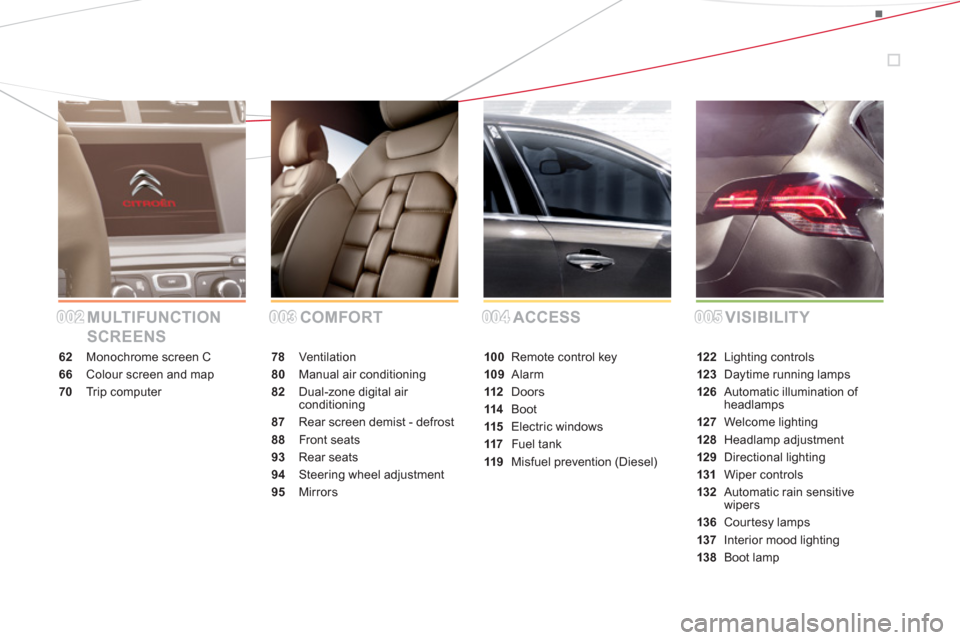
MULTIFUNCTION
SCREENSCOMFORT ACCESS VISIBILITY
62 Monochrome screen C
66 Colour screen and map
70 Tr i p c o m p u t e r78 Ventilation
80 Manual air conditioning
82 Dual-zone digital air
conditioning
87 Rear screen demist - defrost
88 Front seats
93 Rear seats
94 Steering wheel adjustment
95 Mirrors100 Remote control key
109 Alarm
112 Doors
114 Boot
115 Electric windows
117 Fuel tank
119 Misfuel prevention (Diesel)122 Lighting controls
123 Daytime running lamps
126 Automatic illumination of
headlamps
127 Welcome lighting
128 Headlamp adjustment
129 Directional lighting
131 Wiper controls
132 Automatic rain sensitive
wipers
136 Courtesy lamps
137 Interior mood lighting
138 Boot lamp
004004005005002002003003
Page 6 of 396
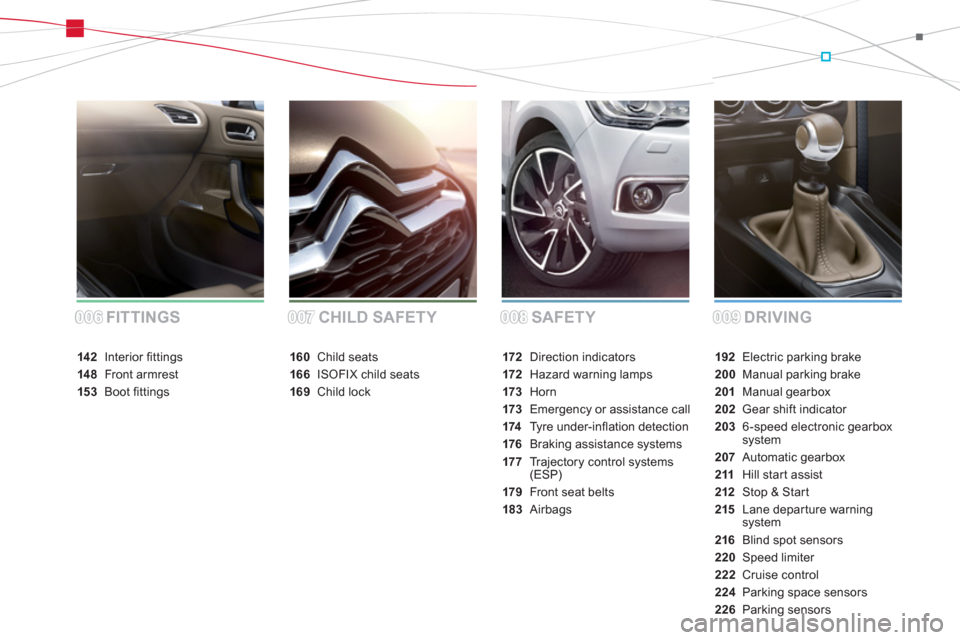
SAFETY DRIVING FITTINGS CHILD SAFETY
192 Electric parking brake
200 Manual parking brake
201 Manual gearbox
202 Gear shift indicator
203 6 -speed electronic gearbox
system
207 Automatic gearbox
211 Hill start assist
212 Stop & Start
215 Lane depar ture warning
system
216 Blind spot sensors
220 Speed limiter
222 Cruise control
224 Parking space sensors
226 Parking sensors 172 Direction indicators
172 Hazard warning lamps
173 Horn
173 Emergency or assistance call
174 Ty r e u n d e r- i nfl ation detection
176 Braking assistance systems
17 7 Trajectory control systems
(ESP)
179 Front seat belts
183 Airbags 160 Child seats
166 ISOFIX child seats
169 Child lock 142 Interior fi ttings
14 8 Front armrest
15 3 Boot fi ttings
008008009009006006007007
Page 20 of 396

Sitting comfortably
Head restraint height and angle
Front seats
Other functions available...
Lumbar massage.
Storing driving positions
(dr iver 's elec tr ic seat).
Heated seats.
90
1.
Release the steering wheel.
2.
Adjust for height and reach.
3.
Lock the steering wheel.
Steering wheel adjustment
94
As a safety precaution, these
operations must only be carried out
when stationary.
Lumbar
91
Page 37 of 396
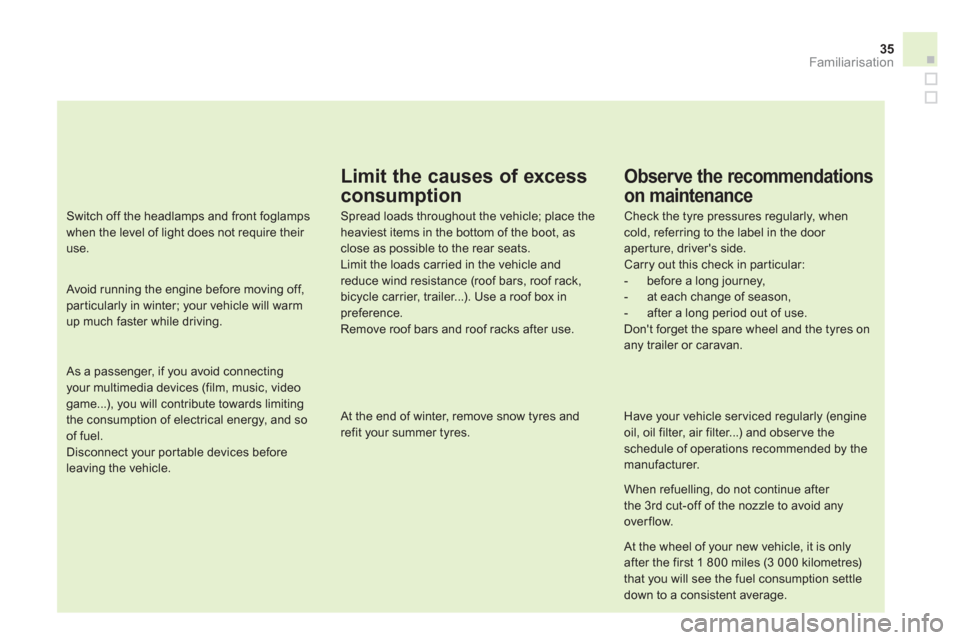
35
Limit the causes of excess
consumption
Spread loads throughout the vehicle; place the
heaviest items in the bottom of the boot, as
close as possible to the rear seats.
Limit the loads carried in the vehicle and
reduce wind resistance (roof bars, roof rack,
bicycle carrier, trailer...). Use a roof box in
preference.
Remove roof bars and roof racks after use.
At the end of winter, remove snow tyres and
refit your summer tyres.
Observe the recommendations
on maintenance
Check the tyre pressures regularly, when
cold, referring to the label in the door
aperture, driver's side.
Carry out this check in par ticular:
- before a long journey,
- at each change of season,
- after a long period out of use.
Don't forget the spare wheel and the tyres on
any trailer or caravan.
Have your vehicle ser viced regularly (engine
oil, oil filter, air filter...) and obser ve the
schedule of operations recommended by the
manufacturer.
When refuelling, do not continue after
the 3 rd cut-off of the nozzle to avoid any
over flow.
At the wheel of your new vehicle, it is only
after the first 1 800 miles (3 000 kilometres)
that you will see the fuel consumption settle
down to a consistent average.
Switch off the headlamps and front foglamps
when the level of light does not require their
use.
Avoid running the engine before moving off,
particularly in winter; your vehicle will warm
up much faster while driving.
As a passenger, if you avoid connecting
your multimedia devices (film, music, video
game...), you will contribute towards limiting
the consumption of electrical energy, and so
of fuel.
Disconnect your portable devices before
leaving the vehicle.
Familiarisation
Page 90 of 396

Front seats
Seat consisting of a seat cushion, a seat back and a head restraint which can all be adjusted to
adapt your position for ease of driving and comfort.
Manual adjustments
Forwards-backwards adjustment
�)
Raise the control and slide the seat
for wards or backwards.
Driver's or passenger's seat
height adjustment
�)
Pull the control upwards to raise or push
it downwards to lower, as many times as
necessary, to obtain the position required.
Seat back angle adjustment
�)
Turn the control knob to adjust the seat
backrest angle.
As a safety measure, seat adjustments
should only be done when stationary.
Page 91 of 396
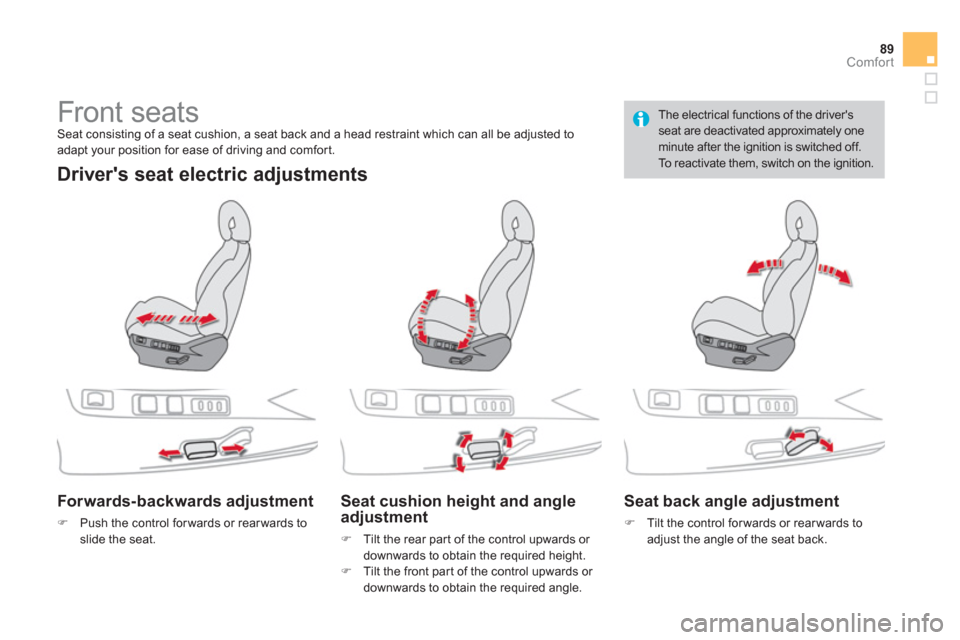
89Comfort
Front seats
Seat consisting of a seat cushion, a seat back and a head restraint which can all be adjusted to
adapt your position for ease of driving and comfort.
Driver's seat electric adjustments
Forwards-backwards adjustment
�)
Push the control for wards or rear wards to
slide the seat.
Seat cushion height and angle
adjustment
�)
Tilt the rear part of the control upwards or
downwards to obtain the required height.
�)
Tilt the front part of the control upwards or
downwards to obtain the required angle.
Seat back angle adjustment
�)
Tilt the control for wards or rear wards to
adjust the angle of the seat back.
The electrical functions of the driver's
seat are deactivated approximately one
minute after the ignition is switched off.
To reactivate them, switch on the ignition.
Page 92 of 396
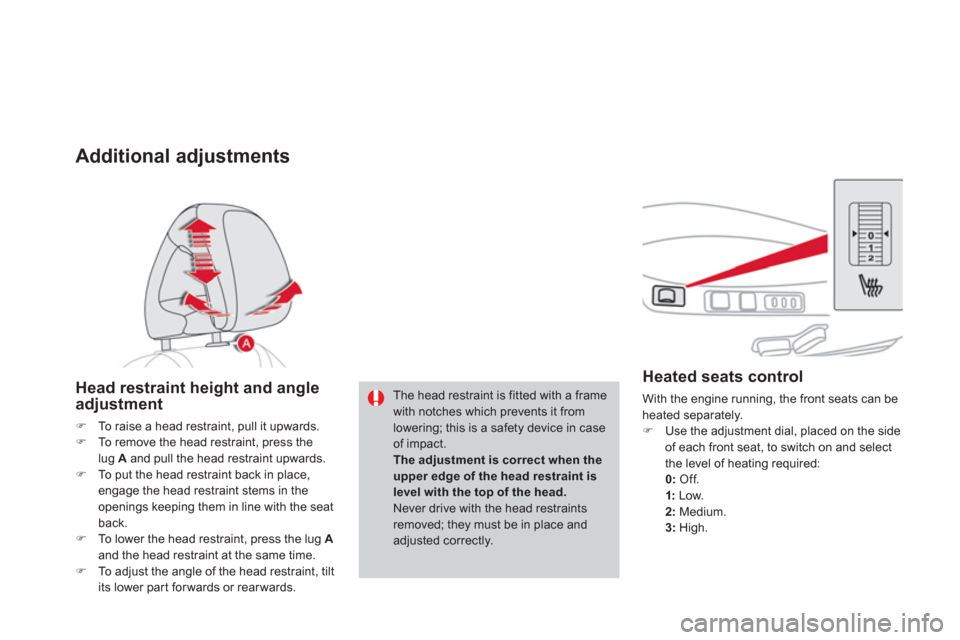
Heated seats control
With the engine running, the front seats can be
heated separately.
�)
Use the adjustment dial, placed on the side
of each front seat, to switch on and select
the level of heating required:
0:
Off.
1
:
Low.
2
:
Medium.
3
:
High.
Additional adjustments
Head restraint height and angle
adjustment
�)
To raise a head restraint, pull it upwards.
�)
To remove the head restraint, press the
lug A
and pull the head restraint upwards.
�)
To put the head restraint back in place,
engage the head restraint stems in the
openings keeping them in line with the seat
back.
�)
To lower the head restraint, press the lug A
and the head restraint at the same time.
�)
To adjust the angle of the head restraint, tilt
its lower part for wards or rear wards. The head restraint is fitted with a frame
with notches which prevents it from
lowering; this is a safety device in case
of impact.
The adjustment is correct when the
upper edge of the head restraint is
level with the top of the head.
Never drive with the head restraints
removed; they must be in place and
adjusted correctly.
Page 95 of 396
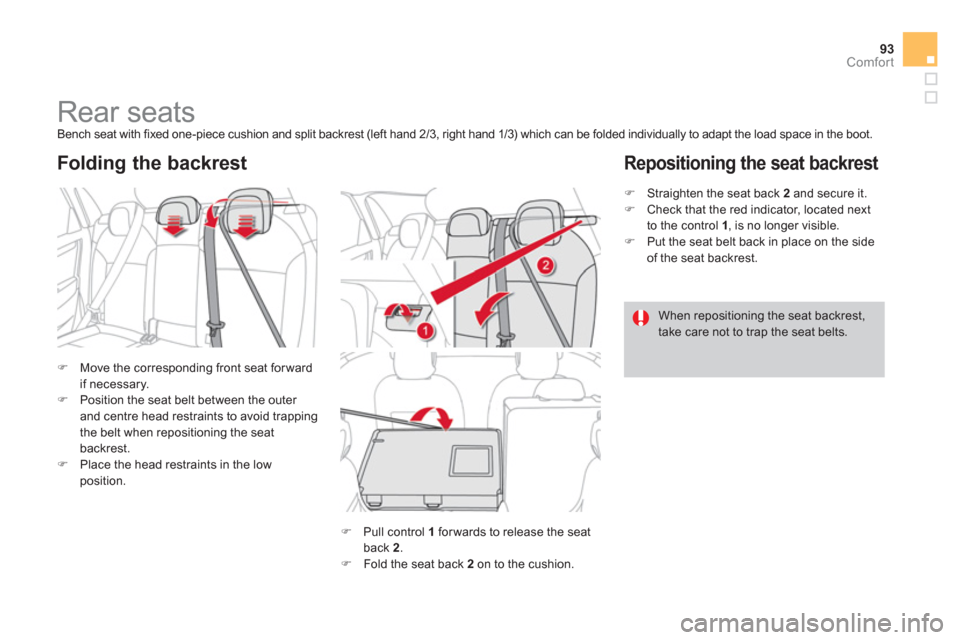
93Comfort
Rear seats
Bench seat with fixed one-piece cushion and split backrest (left hand 2/3, right hand 1/3) which can be folded individually to adapt the load space in the boot.
�)
Move the corresponding front seat for ward
if necessary.
�)
Position the seat belt between the outer
and centre head restraints to avoid trapping
the belt when repositioning the seat
backrest.
�)
Place the head restraints in the low
position.
Folding the backrest
�)
Pull control 1
for wards to release the seat
back 2
.
�)
Fold the seat back 2
on to the cushion.
�)
Straighten the seat back 2
and secure it.
�)
Check that the red indicator, located next
to the control 1
, is no longer visible.
�)
Put the seat belt back in place on the side
of the seat backrest.
Repositioning the seat backrest
When repositioning the seat backrest,
take care not to trap the seat belts.
Page 116 of 396
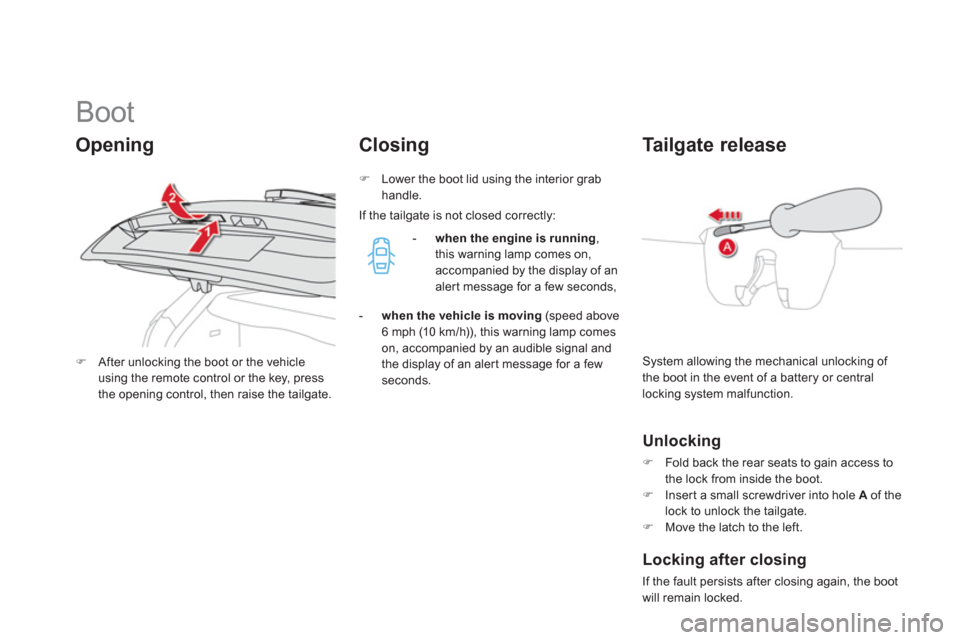
Boot
System allowing the mechanical unlocking of
the boot in the event of a battery or central
locking system malfunction.
Ta i l g a t e r e l e a s e
Unlocking
�)
Fold back the rear seats to gain access to
the lock from inside the boot.
�)
Inser t a small screwdriver into hole A
of the
lock to unlock the tailgate.
�)
Move the latch to the left.
�)
After unlocking the boot or the vehicle
using the remote control or the key, press
the opening control, then raise the tailgate.
Opening
Closing
�)
Lower the boot lid using the interior grab
handle.
- when the engine is running
,
this warning lamp comes on,
accompanied by the display of an
aler t message for a few seconds,
- when the vehicle is moving
(speed above
6 mph (10 km/h)), this warning lamp comes
on, accompanied by an audible signal and
the display of an aler t message for a few
seconds.
Locking after closing
If the fault persists after closing again, the boot
will remain locked.
If the tailgate is not closed correctly:
Page 130 of 396
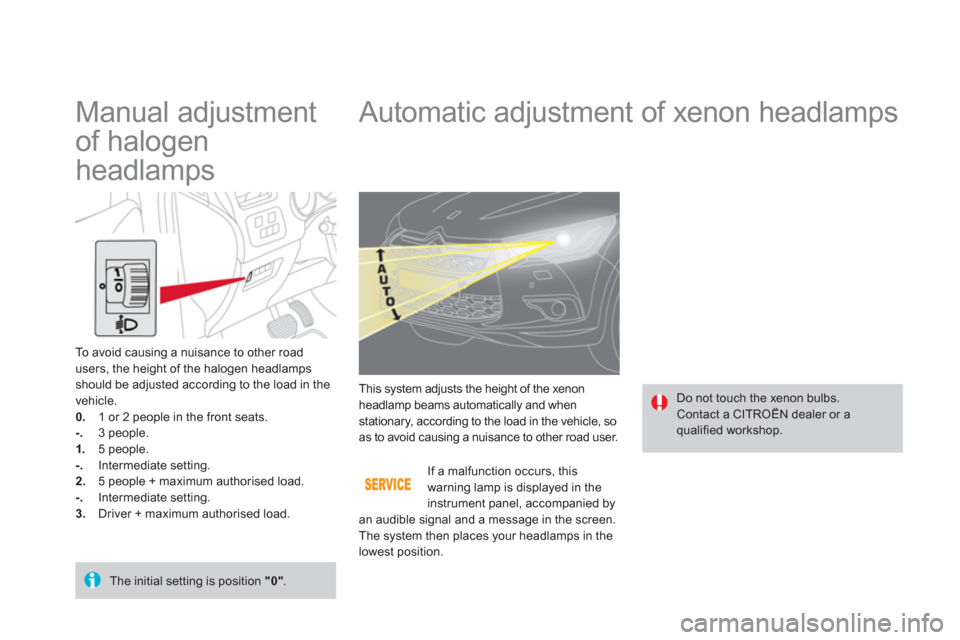
Automatic adjustment of xenon headlamps
Do not touch the xenon bulbs.
Contact a CITROËN dealer or a
qualified workshop. This system adjusts the height of the xenon
headlamp beams automatically and when
stationary, according to the load in the vehicle, so
as to avoid causing a nuisance to other road user.
If a malfunction occurs, this
warning lamp is displayed in the
instrument panel, accompanied by
an audible signal and a message in the screen.
The system then places your headlamps in the
lowest position.
Manual adjustment
of halogen
headlamps
To avoid causing a nuisance to other road
users, the height of the halogen headlamps
should be adjusted according to the load in the
vehicle.
0.
1 or 2 people in the front seats.
-.
3 people.
1.
5 people.
-.
Intermediate setting.
2.
5 people + maximum authorised load.
-.
Intermediate setting.
3.
Driver + maximum authorised load.
The initial setting is position "0"
.